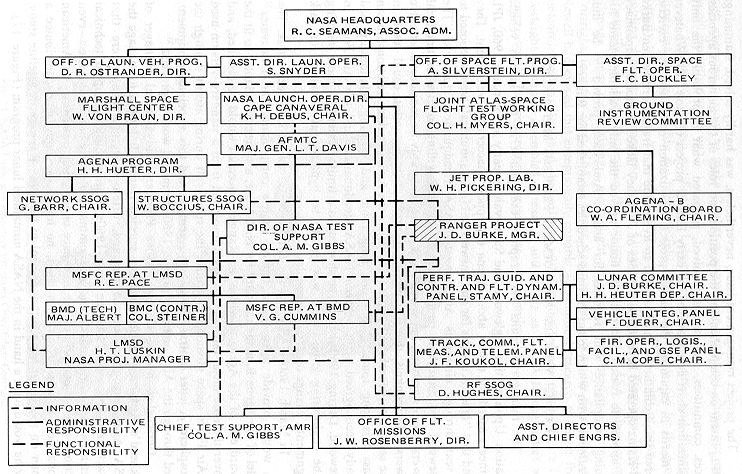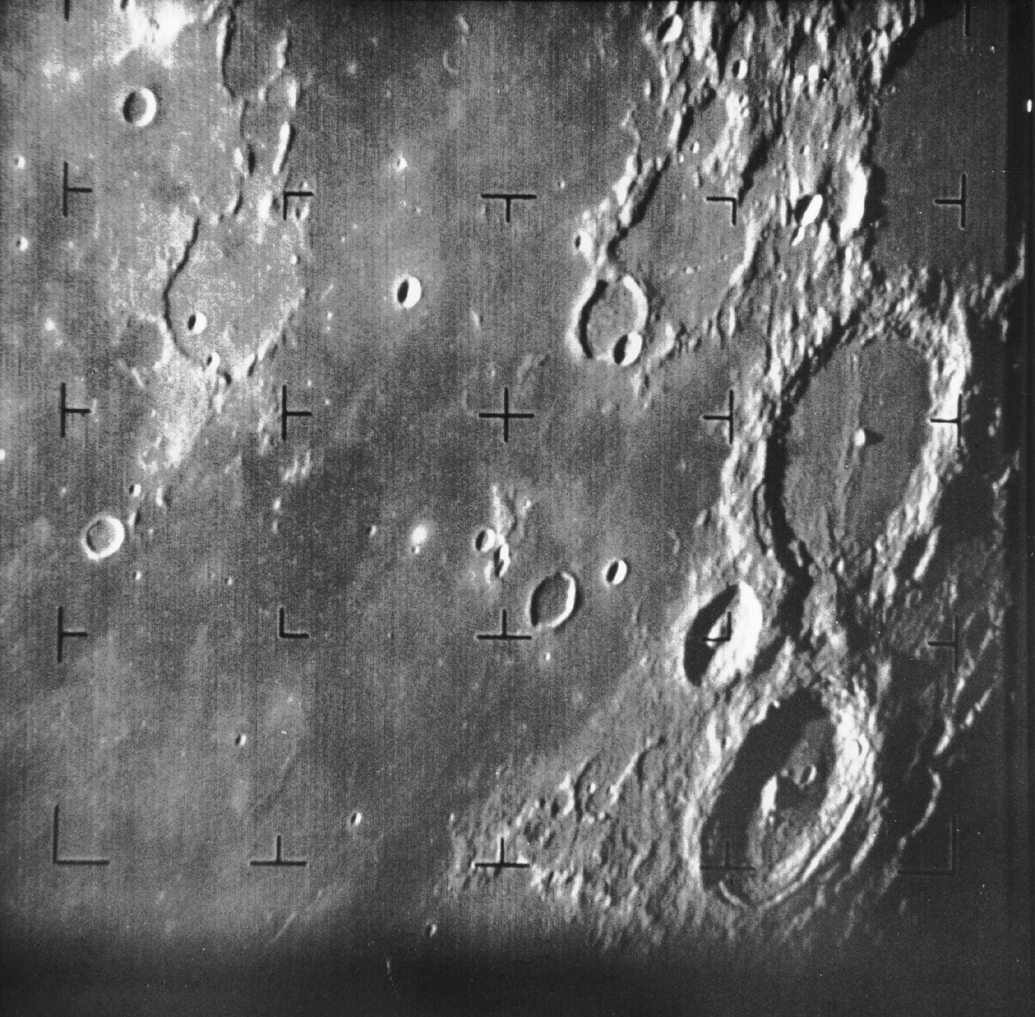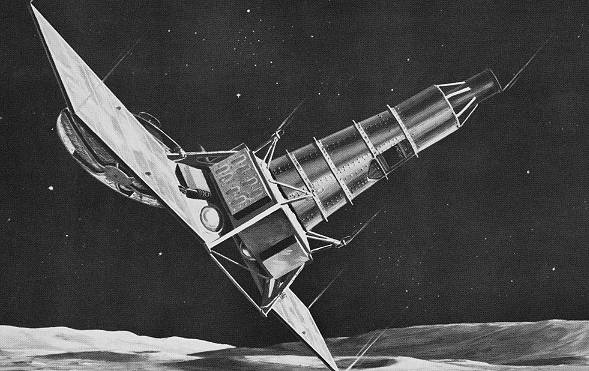|
Ranger Program
The Ranger program was a series of unmanned space missions by the United States in the 1960s whose objective was to obtain the first close-up images of the surface of the Moon. The Ranger spacecraft were designed to take images of the lunar surface, transmitting those images to Earth until the spacecraft were destroyed upon impact. A series of mishaps, however, led to the failure of the first six flights. At one point, the program was called "shoot and hope". Congress launched an investigation into "problems of management" at NASA Headquarters and Jet Propulsion Laboratory. After two reorganizations of the agencies, Ranger 7 successfully returned images in July 1964, followed by two more successful missions. Ranger was originally designed, beginning in 1959, in three distinct phases, called "blocks". Each block had different mission objectives and progressively more advanced system design. The JPL mission designers planned multiple launches in each block, to maximize the engin ... [...More Info...] [...Related Items...] OR: [Wikipedia] [Google] [Baidu] |
Jet Propulsion Laboratory
The Jet Propulsion Laboratory (JPL) is a federally funded research and development center and NASA field center in the City of La Cañada Flintridge, California, United States. Founded in the 1930s by Caltech researchers, JPL is owned by NASA and managed by the nearby California Institute of Technology (Caltech). The laboratory's primary function is the construction and operation of planetary robotic spacecraft, though it also conducts Earth-orbit and astronomy missions. It is also responsible for operating the NASA Deep Space Network. Among the laboratory's major active projects are the Mars 2020 mission, which includes the '' Perseverance'' rover and the '' Ingenuity'' Mars helicopter; the Mars Science Laboratory mission, including the ''Curiosity'' rover; the InSight lander (''Interior Exploration using Seismic Investigations, Geodesy and Heat Transport''); the ''Mars Reconnaissance Orbiter''; the '' Juno'' spacecraft orbiting Jupiter; the ''SMAP'' satellite for earth surface ... [...More Info...] [...Related Items...] OR: [Wikipedia] [Google] [Baidu] |
Mariner 2
Mariner 2 (Mariner-Venus 1962), an American space probe to Venus, was the first robotic space probe to conduct a successful planetary encounter. The first successful spacecraft in the NASA Mariner program, it was a simplified version of the Block I spacecraft of the Ranger program and an exact copy of Mariner 1. The missions of the Mariner 1 and 2 spacecraft are sometimes known as the Mariner R missions. Original plans called for the probes to be launched on the Atlas-Centaur, but serious developmental problems with that vehicle forced a switch to the much smaller Agena B second stage. As such, the design of the Mariner R vehicles was greatly simplified. Far less instrumentation was carried than on the Soviet Venera probes of this period—for example, forgoing a TV camera—as the Atlas-Agena B had only half as much lift capacity as the Soviet 8K78 booster. The Mariner 2 spacecraft was launched from Cape Canaveral on August 27, 1962, and passed as close as to Venus on De ... [...More Info...] [...Related Items...] OR: [Wikipedia] [Google] [Baidu] |
Alphonsus Crater
Alphonsus is an ancient impact crater on the Moon that dates from the pre-Nectarian era. It is located on the lunar highlands on the eastern end of Mare Nubium, west of the Imbrian Highlands, and slightly overlaps the crater Ptolemaeus to the north. To the southwest is the smaller Alpetragius. Description The surface of Alphonsus is broken and irregular along its boundary with Ptolemaeus. The outer walls are slightly distorted and possess a somewhat hexagonal form. A low ridge system of deposited ejecta bisects the crater floor, and includes the steep central peak designated Alphonsus Alpha (α). This pyramid-shaped formation rises to a height of 1.5 km above the interior surface. It is not volcanic in origin, but rather is made of anorthosite like the lunar highlands. The floor is fractured by an elaborate system of rilles and contains four or five smaller craters surrounded by a symmetric darker halo. These dark-halo craters are cinder cone-shaped and are believed by s ... [...More Info...] [...Related Items...] OR: [Wikipedia] [Google] [Baidu] |
Ranger 9
Ranger 9 was a Lunar probe, launched in 1965 by NASA. It was designed to achieve a lunar impact trajectory and to transmit high-resolution photographs of the lunar surface during the final minutes of flight up to impact. The spacecraft carried six television vidicon cameras—two wide-angle (channel F, cameras A and B) and four narrow-angle (channel P)—to accomplish these objectives. The cameras were arranged in two separate chains, or channels, each self-contained with separate power supplies, timers, and transmitters so as to afford the greatest reliability and probability of obtaining high-quality television pictures. These images were broadcast live on television to millions of viewers across the United States. No other experiments were carried on the spacecraft. Spacecraft design Rangers 6, 7, 8, and 9 were the so-called Block 3 versions of the Ranger spacecraft. The spacecraft consisted of a hexagonal aluminium frame base 1.5 m across on which was mounted the propul ... [...More Info...] [...Related Items...] OR: [Wikipedia] [Google] [Baidu] |
Mare Tranquillitatis
Mare Tranquillitatis (Latin ''tranquillitātis'', the Sea of Tranquillity or Sea of Tranquility; see spelling differences) is a lunar mare that sits within the Tranquillitatis basin on the Moon. It is the first location on another world to be visited by humans. The mare material within the basin consists of basalt formed in the intermediate to young age group of the Upper Imbrian epoch. The surrounding mountains are thought to be of the Lower Imbrian epoch, but the actual basin is probably Pre-Nectarian. The basin has irregular margins and lacks a defined multiple-ringed structure. The irregular topography in and near this basin results from the intersection of the Tranquillitatis, Nectaris, Crisium, Fecunditatis, and Serenitatis basins with two throughgoing rings of the Procellarum basin. Palus Somni, on the northeastern rim of the mare, is filled with the basalt that spilled over from Tranquillitatis. This mare has a slight bluish tint relative to the rest of the Moon ... [...More Info...] [...Related Items...] OR: [Wikipedia] [Google] [Baidu] |
Ranger 8
Ranger 8 was a lunar probe in the Ranger program, a robotic spacecraft series launched by NASA in the early-to-mid-1960s to obtain the first close-up images of the Moon's surface. These pictures helped select landing sites for Apollo missions and were used for scientific study. During its 1965 mission, Ranger 8 transmitted 7,137 lunar surface photographs before it crashed into the Moon as planned. This was the second successful mission in the Ranger series, following Ranger 7. Ranger 8's design and purpose were very similar to those of Ranger 7. It had six television vidicon cameras: two full-scan and four partial-scan. Its sole purpose was to document the Moon's surface. Spacecraft design General Ranger spacecraft were originally designed, beginning in 1959, in three distinct phases called "blocks". Rangers 6, 7, 8, and 9 were the Block 3 versions. The spacecraft consisted of a hexagonal aluminum frame base 1.5 m across on which was mounted the propulsion and powe ... [...More Info...] [...Related Items...] OR: [Wikipedia] [Google] [Baidu] |
Mare Cognitum
Mare Cognitum (Latin ''cognitum'', the "Sea that has Become Known") is a lunar mare located in a basin or large crater which sits in the second ring of Oceanus Procellarum. To the northwest of the mare is the Montes Riphaeus mountain range, part of the rim of the buried crater or basin containing the mare. Previously unnamed, the mare received its name in 1964 in reference to its selection as the target for the successful impact probe Ranger 7, the first American spacecraft to return closeup images of the Moon's surface. Origin The basin material is of the Pre-Nectarian epoch, while most of the basaltic mare material is of the Upper Imbrian epoch. Exploration The Ranger 7 lunar probe impacted Mare Cognitum at the conclusion of its picture-taking mission. Surveyor 3 and Apollo 12 landed near its northern shore. The outcrop of the Fra Mauro formation, where Apollo 14 landed, is also located near Mare Cognitum. Statio Cognitum On November 19, 1969, astronauts Pete Conrad ... [...More Info...] [...Related Items...] OR: [Wikipedia] [Google] [Baidu] |
Ranger 6
Ranger 6 was a lunar probe in the NASA Ranger program, a series of robotic spacecraft of the early and mid-1960s to obtain the first close-up images of the Moon's surface. It was launched on January 30, 1964 and was designed to transmit high-resolution photographs of the lunar terrain during the final minutes of flight until impacting the surface. The spacecraft carried six television vidicon cameras - two wide-angle (channel F, cameras A and B) and four narrow-angle (channel P) - to accomplish these objectives. The cameras were arranged in two separate chains, or channels, each self-contained with separate power supplies, timers, and transmitters so as to afford the greatest reliability and probability of obtaining high-quality television pictures. No other experiments were carried on the spacecraft. Due to a failure of the camera system, no images were returned. Spacecraft design Rangers 6, 7, 8, and 9 were called Block 3 versions of the Ranger spacecraft. The spacecraft con ... [...More Info...] [...Related Items...] OR: [Wikipedia] [Google] [Baidu] |
Ranger 6789
A Ranger is typically someone in a military/paramilitary or law enforcement role specializing in patrolling a given territory, called “ranging”. The term most often refers to: * Park ranger or forest ranger, a person charged with protecting and preserving protected parklands and forests. ** National Park Service ranger, an employee of the National Park Service ** U.S. Forest Service ranger, an employee of the United States Forest Service ** Ranger of Windsor Great Park, a ceremonial office of the United Kingdom * Ranger (character class), a class that appears in many different role-playing games Ranger or Rangers may also refer to: Arts and entertainment Publications * Ranger's Apprentice, a series of novels by John Flanagan * '' Ranger Rick'', a children's nature magazine published by the United States National Wildlife Federation * ''Ranger'' (magazine), a former British comic magazine Fictional entities * Rangers (comics), a Marvel Comics superhero team * Ranger (Middl ... [...More Info...] [...Related Items...] OR: [Wikipedia] [Google] [Baidu] |
Far Side (Moon)
The far side of the Moon is the lunar hemisphere that always faces away from Earth, opposite to the near side, because of synchronous rotation in the Moon's orbit. Compared to the near side, the far side's terrain is rugged, with a multitude of impact craters and relatively few flat and dark lunar maria ("seas"), giving it an appearance closer to other barren places in the Solar System such as Mercury and Callisto. It has one of the largest craters in the Solar System, the South Pole–Aitken basin. The hemisphere is sometimes called the "dark side of the Moon", where "dark" means "unknown" instead of "lacking sunlight" each side of the Moon experiences two weeks of sunlight while the opposite side experiences two weeks of night. About 18 percent of the far side is occasionally visible from Earth due to libration. The remaining 82 percent remained unobserved until 1959, when it was photographed by the Soviet Luna 3 space probe. The Soviet Academy of Sciences published the f ... [...More Info...] [...Related Items...] OR: [Wikipedia] [Google] [Baidu] |
Ranger 5
Ranger 5 was a spacecraft of the Ranger program designed to transmit pictures of the lunar surface to Earth stations during a period of 10 minutes of flight prior to impacting on the Moon, to rough-land a seismometer capsule on the Moon, to collect gamma-ray data in flight, to study radar reflectivity of the lunar surface, and to continue testing of the Ranger program for development of lunar and interplanetary spacecraft. Due to an unknown malfunction, the spacecraft ran out of power and ceased operation. It passed within 725 km of the Moon. Spacecraft design Ranger 5 was a Block II Ranger spacecraft similar to Ranger 3 and Ranger 4. The basic vehicle was 3.1 m high and consisted of a lunar capsule covered with a balsawood impact-limiter, 65 cm in diameter, a mono-propellant mid-course motor, a retrorocket with a thrust of 5080 lbf (23 kN), and a gold and chrome plated hexagonal base 1.5 m in diameter. A large high-gain dish antenna was attached to the base. ... [...More Info...] [...Related Items...] OR: [Wikipedia] [Google] [Baidu] |
Ranger 4
Ranger 4 was a spacecraft of the Ranger program, launched in 1962. It was designed to transmit pictures of the lunar surface to Earth stations during a period of 10 minutes of flight prior to crashing upon the Moon, to rough-land a seismometer capsule on the Moon, to collect gamma-ray data in flight, to study radar reflectivity of the lunar surface, and to continue testing of the Ranger program for development of lunar and interplanetary spacecraft. An onboard computer failure caused failure of the deployment of the solar panels and navigation systems; as a result the spacecraft crashed on the far side of the Moon without returning any scientific data. It was the first spacecraft of the United States to reach another celestial body. Spacecraft design Ranger 4 was a Block II Ranger spacecraft virtually identical to Ranger 3. The basic vehicle was , high and consisted of a lunar capsule covered with a balsawood impact-limiter, in diameter, a mono-propellant mid-course motor, a ... [...More Info...] [...Related Items...] OR: [Wikipedia] [Google] [Baidu] |








.png)